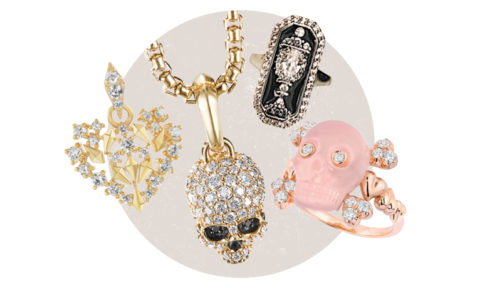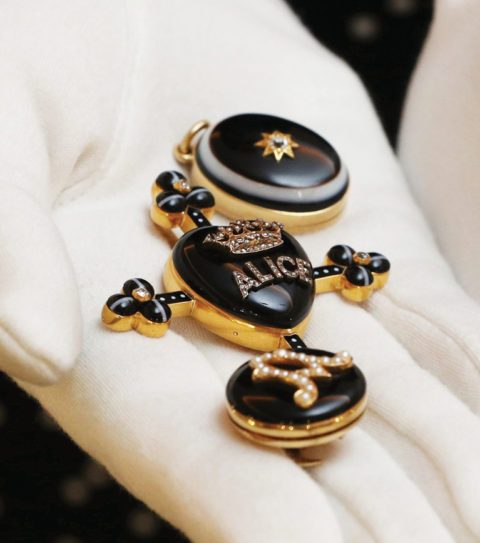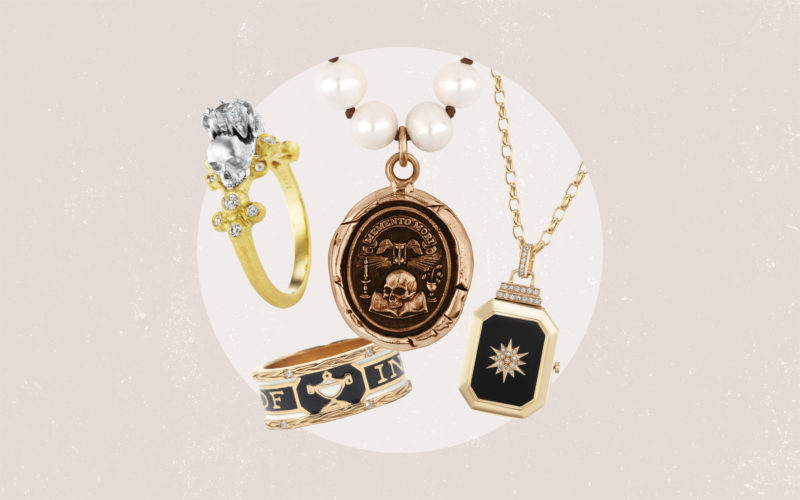From rings engraved with skulls to pendants holding locks of hair, ‘memento mori’ jewellery is regaining popularity in the 21st century.
Death is strangely trendy these days. It has never not been a trend, let’s face it, but the goth, zomboid edge in jewellery is really having a moment. Most of the time, death is not what we want to wear on our finger, wrist or neck, but it has become popular in the wake of the pandemic. In the plague-y Middle Ages, for instance, memento mori (remember you must die) pieces abounded. Inlaid and engraved with skeletons and skulls, graveyard diggers or winged hourglasses, death jewellery reminded us that we are born with one foot in the grave — and that the other should be dancing a jig or seizing the day. “Eat, drink and be merry,” said our rings and necklaces.
The fashion for mourning jewellery comes and goes, but it often surges each time a historical heavyweight expires — like Charles I. When he lost his head in 1649 after dissolving parliament too many times, his supporters circulated flat-topped crystal-quartz rings decorated with a golden crown or the king’s initials. Miniature portraits of Charles proliferated in lockets and pendants inscribed with the mournful message “The glory of England has departed.”

Planning ahead
Before William Shakespeare departed (a few decades ahead of Charles), he set money aside for good friends to have rings made in his memory. And Samuel Pepys arranged for over a hundred mourning rings to be distributed among his family, friends and servants after his death. Mourning jewellery was as much a marker of death then as coffins and widow’s weeds were.
Royal grief
But it wasn’t until Queen Victoria came along that mourning jewellery truly took off. Victoria had always been a jewellery fanatic. Prince Albert created and commissioned many pieces for her during their years together, and when he died in 1861, Victoria naturally expressed their love in mourning jewellery. From the Victorian era arose a new decorative vocabulary for death and commemoration. Funereal images of urns and weeping willows multiplied. Pearls symbolizing tears and winged cherubs of everlasting love poured forth. Clouds became shorthand for Heaven, and knots and ships’ anchors telegraphed the steadfast bonds between the dead and the living.
The jet set
The iconic Victorian mourning material was jet — a lightweight fossilized wood compressed into striations in the coastal cliffs of Whitby in northeast England. Matte black jet was hand-carved or lathed into jewellery and polished to a high sheen with congealed river mud. By the mid-1800s, Whitby had gone from having 50 jet manufacturing workshops to 200, employing around 1,500 men.
Besides jet, there were other sombre-hued stones and materials that became morbidly stylish in Victoria’s day. Onyx, black tortoiseshell, vulcanite and bog oak were staples, as were agate, gold, ivory and garnet.
When Victoria and Albert’s daughter Alice died at age 35, her mother had a dramatic piece created consisting of a black onyx heart in the centre of a Rosicrucian onyx and enamel cross. “Alice” was spelled out in diamonds beneath a diamond-studded crown. When Victoria’s mother died, Albert had a pendant made out of diamonds and agate with a miniature portrait inside and a consoling message inscribed on the outside.

Hair and heartbreak
Brooches, cameos, bracelets, pendants, rings and lockets were favourite forms of jewellery because they could contain something of the dearly departed. Mourning jewellery was intensely personal, with its etched inscriptions and initials, pictures and locks of hair under glass. Hair was especially popular because the Victorians believed it was the last remaining essence of the person and therefore sacred.
In the early 19th century, Swedish women created an industry out of hairwork, weaving and braiding hair into jewellery components. They cleaned the hair by boiling it in soda water and then organized and bundled it into different lengths. It was then braided and woven into moulds, which were mounted on round or oval cases. Hair was worked into the design of jewellery pieces, stiffened with egg white, combed and then glued onto the surface to give the piece texture and pattern. Sometimes hair was ground into powder, mixed with sepia-coloured cuttlefish ink and used to paint sad scenes, like a woman weeping next to a tombstone. People even wore bracelets and rings woven out of their loved one’s tresses. At the height of the Victorian mourning jewellery trend, England was importing 50 tonnes of hair a year.
Brooklyn jeweller Margaret Cross has revived haircrafting in contemporary mourning jewellery. Her hair-woven pieces are set in recycled metals and topped with crystal domes.
Ashes to… diamonds?
The most modern iteration of mourning jewellery is lab-grown diamonds created from finely ground cremation ashes. Carbonized and mixed with elements to obtain a hue — like nitrogen for yellow — the ashes are ennobled into (for some of us) the most precious gems of all: a little bit of our loved ones, immortalized and with us till we die.
This article first appeared in FASHION’s October 2023 issue. Find out more here.
